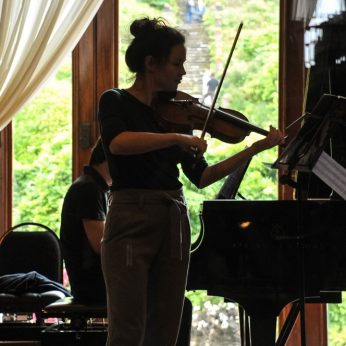Composer: Edvard Grieg (b. 1843 - d. 1907)
Performance date: 29/06/2023
Venue: Bantry House
Composition Year: 1867
Duration: 00:22:29
Recording Engineer: Tom Norton, RTÉ
Instrumentation: vn, pf
Instrumentation Category:Duo
Artists:
Mairead Hickey -
[violin]
Jérémie Moreau -
[piano]

Violin Sonata No.2 in G major Op.13 [1867]
1. Lento doloroso – Allegro vivace
2. Allegretto tranquillo
3. Allegro animato
The nineteenth and early twentieth centuries saw a surge in composers writing music that was inspired both by national independence movements and by a determination to escape the overwhelming embrace of German and Austrian music. For most of the nineteenth century Norway was trying to free herself from Swedish sovereignty, eventually succeeding with a peaceful break for independence in 1905. Grieg for his part was early in his life strongly influenced by the violinist and composer, Ole Bull, a pioneering nationalist in Norwegian music. The Norwegian folk instrument par excellence was and still is the Hardanger fiddle and so, when Bull found ways of incorporating the hardingfele dance repertoire into his concert pieces, the violin itself quickly became the sound of Norway.
Grieg’s embrace of Norwegian culture was also a direct result of his marriage in 1867 to his cousin, Nina Hagerup. She was a soprano so inevitably Grieg composed innumerable melodies for her on texts by Norwegian poets. This Sonata is a strikingly happy work, fairly overflowing with joie de vivre and folk tunes, for it was written on their honeymoon.
The work opens with a dark Lento dolorosa where piano and violin in turn and then together sing a sad tune that the fresh and joyful Allegro vivace quickly banishes with one of Grieg’s typically memorable themes. The swaying second subject provides a tender and equally memorable interlude contrasting with the tremendous energy of the Allegro.
The Allegretto tranquillo is a romantic cantabile set of variations using material liberally borrowed from folk music including a cadenza that mimics exactly the Hardanger fiddle. Moments of serenity contrast with outbursts of passion, but the theme keeps returning to its gentle origins. The finale owes its lively rhythm to the traditional dance, the springar. In amongst the dances we find a gentle melody, a moment of quiet amongst the boisterous wedding celebrations that reappears just before the presto coda.
Francis Humphrys
Copyright © 2025 West Cork Music. All rights reserved.
Designed and developed by Matrix Internet